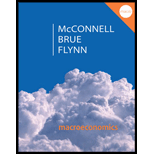
MPC and APC.
Explanation of Solution
MPC is associated to the changes that occur in income and spending. Hence, MPC is calculated by
However, in the case of APC, it is an average where the total amount spent on consumption is compared to the total income earned. Hence, it is calculated as follows:
When there is in increase in the income, two choices available are either to spend or to save the money. As MPC is associated to changes on spent income, the amount that is not spent will have to be saved and this becomes MPS. So, the numerator will have change in the money spent or saved and when added together it has to be the total change in income. So, the denominator will have the total change in income. One will be the result when adding MPS and MPC.
Concept Introduction:
Marginal propensity to consume: Marginal propensity to consume refers to the sensitivity of change in the consumption level due to changes occurred in the income level.
Marginal propensity to save (MPS): Marginal propensity to save refers to the sensitivity of change in the saving level due to changes occurred in the income level.
Want to see more full solutions like this?
Chapter 10 Solutions
Macroeconomics: Principles, Problems, & Policies
- Critically analyse the five (5) characteristics of Ubuntu and provide examples of how they apply to the National Health Insurance (NHI) in South Africa.arrow_forwardCritically analyse the five (5) characteristics of Ubuntu and provide examples of how they apply to the National Health Insurance (NHI) in South Africa.arrow_forwardOutline the nine (9) consumer rights as specified in the Consumer Rights Act in South Africa.arrow_forward
- In what ways could you show the attractiveness of Philippines in the form of videos/campaigns to foreign investors? Cite 10 examples.arrow_forwardExplain the following terms and provide an example for each term: • Corruption • Fraud • Briberyarrow_forwardIn what ways could you show the attractiveness of a country in the form of videos/campaigns?arrow_forward
 Economics (MindTap Course List)EconomicsISBN:9781337617383Author:Roger A. ArnoldPublisher:Cengage Learning
Economics (MindTap Course List)EconomicsISBN:9781337617383Author:Roger A. ArnoldPublisher:Cengage Learning

 Macroeconomics: Principles and Policy (MindTap Co...EconomicsISBN:9781305280601Author:William J. Baumol, Alan S. BlinderPublisher:Cengage Learning
Macroeconomics: Principles and Policy (MindTap Co...EconomicsISBN:9781305280601Author:William J. Baumol, Alan S. BlinderPublisher:Cengage Learning
 Microeconomics: Private and Public Choice (MindTa...EconomicsISBN:9781305506893Author:James D. Gwartney, Richard L. Stroup, Russell S. Sobel, David A. MacphersonPublisher:Cengage Learning
Microeconomics: Private and Public Choice (MindTa...EconomicsISBN:9781305506893Author:James D. Gwartney, Richard L. Stroup, Russell S. Sobel, David A. MacphersonPublisher:Cengage Learning





